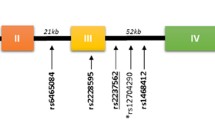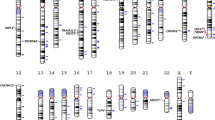Abstract
Schizophrenia is a severe and highly heritable neuropsychiatric disorder. Recent genetic analyses including genome-wide association studies (GWAS) have implicated multiple genome-wide significant variants for schizophrenia among European populations. However, many of these risk variants were not largely validated in other populations of different ancestry such as Asians. To validate whether these European GWAS significant loci are associated with schizophrenia in Asian populations, we conducted a systematic literature search and meta-analyses on 19 single nucleotide polymorphisms (SNPs) in Asian populations by combining all available case-control and family-based samples, including up to 30,000 individuals. We employed classical fixed (or random) effects inverse variance weighted methods to calculate summary odds ratios (ORs) and 95 % confidence intervals (CIs). Among the 19 GWAS loci, we replicated the risk associations of nine markers (e.g., SNPs at VRK2, ITIH3/4, NDST3, NOTCH4) surpassing significance level (two-tailed P < 0.05), and three additional SNPs in MIR137 and ZNF804A also showed trend associations (one-tailed P < 0.05). These risk associations are in the same directions of allelic effects between Asian replication samples and initial European GWAS findings, and the successful replications of these GWAS loci in a different ethnic group provide stronger evidence for their clinical associations with schizophrenia. Further studies, focusing on the molecular mechanisms of these GWAS significant loci, will become increasingly important for understanding of the pathogenesis to schizophrenia.





Similar content being viewed by others
References
Schizophrenia Working Group of the Psychiatric Genomics Consortium (2014) Biological insights from 108 schizophrenia-associated genetic loci. Nature 511:421–427
Saha S, Chant D, Welham J, McGrath J (2005) A systematic review of the prevalence of schizophrenia. PLoS Med 2, e141
Sullivan PF, Kendler KS, Neale MC (2003) Schizophrenia as a complex trait: evidence from a meta-analysis of twin studies. Arch Gen Psychiatry 60:1187–1192
O’Donovan MC, Craddock N, Norton N, Williams H, Peirce T et al (2008) Identification of loci associated with schizophrenia by genome-wide association and follow-up. Nat Genet 40:1053–1055
Stefansson H, Ophoff RA, Steinberg S, Andreassen OA, Cichon S et al (2009) Common variants conferring risk of schizophrenia. Nature 460:744–747
Rietschel M, Mattheisen M, Degenhardt F, Genetic R, Outcome in P et al (2012) Association between genetic variation in a region on chromosome 11 and schizophrenia in large samples from Europe. Mol Psychiatry 17:906–917
Lencz T, Guha S, Liu C, Rosenfeld J, Mukherjee S et al (2013) Genome-wide association study implicates NDST3 in schizophrenia and bipolar disorder. Nat Commun 4:2739
Schizophrenia Psychiatric Genome-Wide Association Study Consortium (2011) Genome-wide association study identifies five new schizophrenia loci. Nat Genet 43:969–976
Hamshere ML, Walters JT, Smith R, Richards AL, Green E et al (2013) Genome-wide significant associations in schizophrenia to ITIH3/4, CACNA1C and SDCCAG8, and extensive replication of associations reported by the Schizophrenia PGC. Mol Psychiatry 18:708–712
Ripke S, O’Dushlaine C, Chambert K, Moran JL, Kahler AK et al (2013) Genome-wide association analysis identifies 13 new risk loci for schizophrenia. Nat Genet 45:1150–1159
Li Z, **ang Y, Chen J, Li Q, Shen J et al (2015) Loci with genome-wide associations with schizophrenia in the Han Chinese population. Br J Psychiatry 207:490–494
Takahashi S, Glatt SJ, Uchiyama M, Faraone SV, Tsuang MT (2015) Meta-analysis of data from the Psychiatric Genomics Consortium and additional samples supports association of CACNA1C with risk for schizophrenia. Schizophr Res 168:429–433
Li M, Luo XJ, **ao X, Shi L, Liu XY et al (2011) Allelic differences between Han Chinese and Europeans for functional variants in ZNF804A and their association with schizophrenia. Am J Psychiatry 168:1318–1325
Zhang R, Lu SM, Qiu C, Liu XG, Gao CG et al (2011) Population-based and family-based association studies of ZNF804A locus and schizophrenia. Mol Psychiatry 16:360–361
Huang L, Ohi K, Chang H, Yu H, Wu L et al (2016) A comprehensive meta-analysis of ZNF804A SNPs in the risk of schizophrenia among Asian populations. Am J Med Genet B Neuropsychiatr Genet 171:437–446
Liu Z, Huang L, Luo XJ, Wu L, Li M (2015) MAOA Variants and Genetic Susceptibility to Major Psychiatric Disorders. Mol Neurobiol.
Steinberg S, de Jong S, Irish Schizophrenia Genomics Consortium, Andreassen OA, Werge T et al (2011) Common variants at VRK2 and TCF4 conferring risk of schizophrenia. Hum Mol Genet 20:4076–4081
Li M, Wang Y, Zheng XB, Ikeda M, Iwata N et al (2012) Meta-analysis and brain imaging data support the involvement of VRK2 (rs2312147) in schizophrenia susceptibility. Schizophr Res 142:200–205
Psychiatric Gwas Consortium Bipolar Disorder Working Group (2011) Large-scale genome-wide association analysis of bipolar disorder identifies a new susceptibility locus near ODZ4. Nat Genet 43:977–983
Witt SH, Juraeva D, Sticht C, Strohmaier J, Meier S et al (2014) Investigation of manic and euthymic episodes identifies state- and trait-specific gene expression and STAB1 as a new candidate gene for bipolar disorder. Transl Psychiatry 4, e426
McMahon FJ, Akula N, Schulze TG, Muglia P, Tozzi F et al (2010) Meta-analysis of genome-wide association data identifies a risk locus for major mood disorders on 3p21.1. Nat Genet 42:128–131
Sasayama D, Hori H, Yamamoto N, Nakamura S, Teraishi T et al (2014) ITIH3 polymorphism may confer susceptibility to psychiatric disorders by altering the expression levels of GLT8D1. J Psychiatr Res 50:79–83
Gu LZ, Jiang T, Cheng ZH, Zhang YC, Ou MM et al (2014) rs11098403 polymorphism near NDST3 is associated with a reduced risk of schizophrenia in a Han Chinese population. Neurosci Lett 581:42–45
Zhang C, Lu W, Wang Z, Ni J, Zhang J et al (2016) A comprehensive analysis of NDST3 for schizophrenia and bipolar disorder in Han Chinese. Transl Psychiatry 6, e701
Li T, Li Z, Chen P, Zhao Q, Wang T et al (2010) Common variants in major histocompatibility complex region and TCF4 gene are significantly associated with schizophrenia in Han Chinese. Biol Psychiatry 68:671–673
Su L, Long J, Liang B, Gu L, Pan R et al (2014) Association between the NOTCH4 gene rs3131296 polymorphism with schizophrenia risk in the Chinese Zhuang population and Chinese Han population. Acta Neuropsychiatr 26:240–245
Ikeda M, Aleksic B, Yamada K, Iwayama-Shigeno Y, Matsuo K et al (2013) Genetic evidence for association between NOTCH4 and schizophrenia supported by a GWAS follow-up study in a Japanese population. Mol Psychiatry 18:636–638
Acknowledgments
The authors are deeply grateful for the authors of the included studies to share their results. This work was supported by CAS Pioneer Hundred Talents Program.
Author information
Authors and Affiliations
Corresponding author
Ethics declarations
Conflict of Interest
All authors report no conflicts of interest.
Additional information
**ao **ao, **ong-jian Luo and Hong Chang contributed equally to this work.
Electronic Supplementary Material
Below is the link to the electronic supplementary material.
ESM 1
(PDF 693 kb)
Rights and permissions
About this article
Cite this article
**ao, X., Luo, Xj., Chang, H. et al. Evaluation of European Schizophrenia GWAS Loci in Asian Populations via Comprehensive Meta-Analyses. Mol Neurobiol 54, 4071–4080 (2017). https://doi.org/10.1007/s12035-016-9990-3
Received:
Accepted:
Published:
Issue Date:
DOI: https://doi.org/10.1007/s12035-016-9990-3




